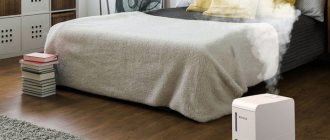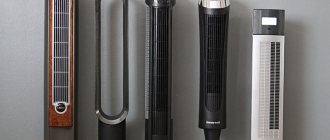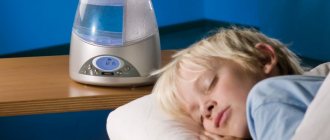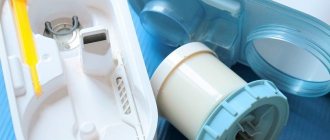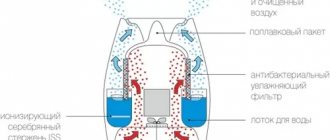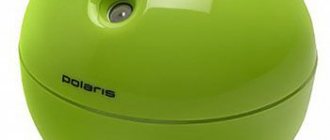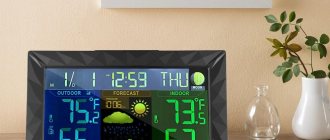An air humidifier is a useful accessory for an apartment. There are many types of devices, the most popular and modern type is the ultrasonic humidifier. This article will describe in detail what it is, how it works, what the benefits and harms of use are, and how to choose an ultrasonic air humidifier for your apartment. The most popular models will be briefly discussed.
Operating principle of an ultrasonic humidifier
Most of the climate control unit is occupied by a water tank, where there is a container with liquid. And only a small part is occupied by the ultrasonic unit. At the base of the tank there was a place for a dosing valve used to adjust the water level in the compartment with the emitter. Some models of ultrasonic humidifiers are equipped with miniature fans used to spray cold steam.
Modern devices boast an integrated hygrostat, an electronic control system for accurately determining the humidity level and adjusting the operating mode of the device. Manufacturers equip climate control units with effective filtration systems, air ionizers and additional programs for convenient use of the device and maintaining a comfortable humidity level in the room.
The operating principle of an ultrasonic humidifier is simple and clear. It can be represented in several successive steps.
- The main functional element of the device is the ultrasonic emitter. It resembles a small ceramic washer to which silver-coated electrodes are connected.
- Vibration of the compact element begins after applying alternating current to it. This achieves the ultrasonic frequency necessary to break the liquid into tiny particles.
- An ultrasonic element in a ceramic washer turns air into an aerosol. The room is filled with a thick water mist, which helps to increase the humidity in the room to comfortable levels.
Operating principle of an ultrasonic humidifier - Modern models of devices are equipped with a hygrometer that displays the humidity in the room. The owner adjusts the program taking into account the displayed information (increases or decreases power).
- After reaching the user-specified humidity values, the humidifier stops working and goes into standby mode. When the humidity in the room decreases, automatic activation is triggered.
Scheme of operation of an ultrasonic humidifier
Now you know how an ultrasonic humidifier works. The circuit is simple - water is supplied to the membrane to which the electrodes are connected. They “accelerate” it to ultrasound, and cold steam is formed. It is then removed and sprayed indoors.
How it works
Active demand for ultrasonic humidifiers creates a number of undeniable advantages. These are safety, operational efficiency, variety of applications, a wide range of additional functions and an attractive design. Such devices are economical in terms of energy consumption and do not create much noise during operation.
Diagram of an ultrasonic humidifier
Let us highlight the main design features of this type of climate control equipment:
- Inside the device there is a container for the main volume of water. There is a UV emitter at the base.
- In the water storage tank you can find a dosing valve that maintains the required water level in the tank.
- Another component is a fan for dispersing water exposed to ultrasonic radiation.
- Hygrostat for determining humidity values.
- Control panel, LCD display.
- Some models additionally have an ionizer, air flavor, various program modes, and so on.
Ultrasonic humidifier: disadvantages and advantages
Automatic devices are equipped with sensors whose functionality includes diagnosing the conditions in the room and selecting the appropriate program to maintain a comfortable microclimate in the room. Filtration systems are built into the air humidifier, which allows you to reduce the concentration of dust in the room. Some devices are equipped with water filters. They remove unwanted salts and other impurities from tap water.
Advantages of climate control units
Ultrasonic air humidifiers have a number of obvious advantages, which are worth dwelling on in more detail:
- minimal noise during operation;
- water is sprayed into microparticles, creating a “cold fog” effect;
- high ergonomics, compact dimensions;
- presence of a built-in hygrometer;
- maintainability of the device.
Disadvantages of ultrasonic devices
Like any technology, climate solutions also have certain disadvantages. Since an ultrasonic humidifier often works with untreated water, a white coating often forms on the furniture around the device - this is the main “disease” of devices of this type. We are talking about salts present in water. When the “cold fog” evaporates, they settle on the furniture, floor, and objects in the room.
As for the ultrasonic emitter itself, it is absolutely harmless to the health of humans and four-legged children. When you inhale steam containing salt particles, they easily enter the lungs. They are invisible to the body of a healthy person, but allergy sufferers and asthmatics will have a hard time. In especially severe cases, attacks of suffocation occur.
It is useful for people with respiratory problems to stay in the room where the device is installed, because the danger of drying out the nasopharyngeal mucosa is eliminated.
The best ultrasonic air humidifier will also have a place in a child’s room, because such a useful device should certainly be in every residential building. The device normalizes respiratory function, saturates the blood, internal organs and brain with oxygen. In a room with optimal humidity, breathing is easy and simple, and sleep is deep and sound.
Rules of use and care
You will have to say goodbye to some of the advantages of a ultrasonic humidifier if you do not comply with the operating requirements. Do not forget that all humidifiers are energy-dependent devices that operate on an electrical network, so they are a priori dangerous if handled carelessly.
The best place to install a humidifier is a free space in the center of the room. This way the moisture will spread evenly around the entire perimeter of the room.
Some operating standards are prescribed by the manufacturer, others are well known and do not require reflection in the instructions.
So, in order for the humidifier to work for a long time, properly and without causing trouble, follow the rules:
- Remove the tank to fill with water only when the power is turned off.
- Use filtered water. If the device has filters, change them on time.
- When using hard water, deposits are deposited inside the structure. To prevent this from happening, the device is regularly cleaned with a solution of citric acid (per 1 liter - 30 grams of dry matter).
- In addition to citric acid, it is allowed to use vinegar, special products for plastic, soap solutions without antibacterial inclusions, and anti-scale agents.
- For reading, you cannot use alcohol solutions, acid other than citric acid, chemical solvents, oils, bleaches, abrasives, or hard brushes. Washing parts of the device in the dishwasher is also prohibited.
- The body of the device is wiped with a micro-lint cloth soaked in water, the tank is removed, soaked and wiped, and the internal elements are also soaked in the solution for 15 minutes.
If the device has an electronic display or indication, carefully monitor the signals and follow the prompts. Manufacturers have tried to make it as comfortable as possible for users of UV devices to use them.
If the device breaks down and you cannot fix it yourself, we recommend contacting a service center. The warranty on some devices is 1 or 2 years, during which time you are required to repair or replace the equipment free of charge.
How to choose an air humidifier for a nursery, home, apartment
On the eve of expanding their family, many parents are wondering how to choose a humidifier for the room of their future child. Climate professionals highlight several key criteria:
- An equally important aspect is the power of the device. Miniature and visually beautiful equipment does not always cope with basic tasks;
- minimum noise level. Humidification is preceded by filling the reservoir with water and a characteristic “gurgling” sound during operation. The acoustic effect during operation should be minimal, otherwise problems with sleep cannot be avoided;
- autonomy of the climate control device - units with a solid water tank work for a long time;
- professionals choose models with integrated water purification systems, which eliminates the “white coating ” in the room.
What kind of water to pour into a humidifier is a question that new owners of climate control equipment ask. The best option is distilled or purified water.
It is important to conduct a detailed analysis of customer reviews in order to obtain objective information about the specific model of the climate control device from the selected manufacturer. The information obtained in this way is much more truthful than the advertising videos of the manufacturing companies. From reviews it is easy to get comprehensive data about the disadvantages and advantages of a particular model.
Watch a video on how to make an ultrasonic humidifier with your own hands and at home:
Despite the fact that the device is simple, it is functional and vital in our homes. The respiratory organs, mucous membrane and skin of a person are sensitive to the lack of humidity in the room. The climatic device maintains a favorable microclimate in the home with filigree ease.
Industrial air humidification units
specializes in the sale, delivery, installation of climate control units, including household and industrial ultrasonic humidifiers and air washers. We also provide certified installation and service of climate control systems. We offer equipment from the Italian manufacturer Carel - reliable and functional multi-zone systems and duct installations that can function in conjunction with fan coils and air conditioners. The Carel humiSonic range of ultrasonic humidifiers is represented by adiabatic devices with a 40 W distribution system and a performance of about 1150 W. These are humidifiers for industrial facilities, characterized by small dimensions, ease of commissioning and ease of operation.
